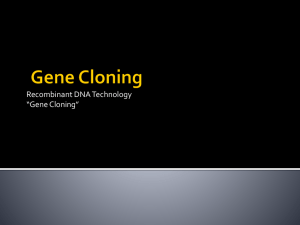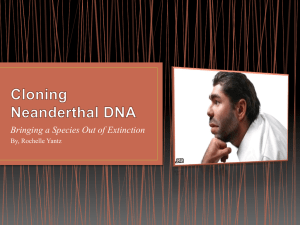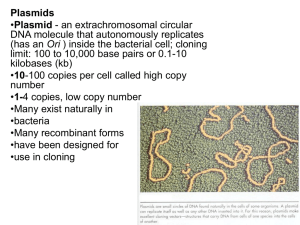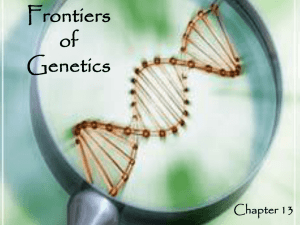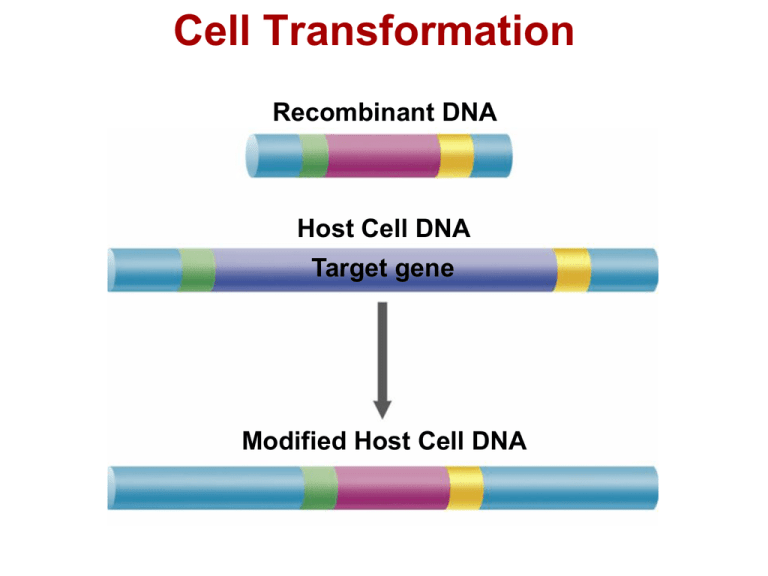
Cell Transformation
Recombinant DNA
Host Cell DNA
Target gene
Modified Host Cell DNA
IB Assessment Statement
State two examples of the current uses of genetically
modified crops or animals.
Examples include salt tolerance in tomato plants,
synthesis of beta-carotene (vitamin A precursor) in
rice, herbicide resistance in crop plants and factor IX
(human blood clotting) in sheep milk.
Copyright Pearson Prentice Hall
Genetic Modification
• Because every living organism has DNA,
Genes from DNA can be transferred
from one organism to another
• Organisms that have had genes
transferred are called genetically
modified organisms.
Genetically Modified Organisms, also
called Transgenic Organisms.
•
An example, is a transfer of the gene for
a resistance to the herbicide glyphosate
from a bacterium to crop plant, so that
the crop can be sprayed with herbicide.
TRANSFORMING BACTERIA
Techniques used in gene transfer into bacteria.
Add a gene into a bacteria is called,
Transforming Bacteria
Transforming Bacteria
During transformation, a cell takes in DNA
from outside the cell. The external DNA
becomes a component of the cell's DNA.
Transforming Bacteria
Foreign DNA is first joined to a small, circular
DNA molecule known as a plasmid.
Plasmids are found naturally in some bacteria
and have been very useful for DNA transfer.
Steps in inserting a gene into a plasmid:
1. Extract/ Remove gene of interest from a
cell
Copyright Pearson Prentice Hall
Steps in inserting a gene into a plasmid:
2. Plasmids are removed from Bacteria Cells.
3. Plasmids are cut open using restriction
enzymes.
Steps in inserting a gene
into a plasmid:
Gene of interest
4. Sticky ends are made
in the plasmid by adding
extra Cytosine
Nucleotides to ends.
5. Gene of interest is
insert into plasmid.
Plasmid
Steps in inserting a gene into a
plasmid:
6. Ligase enzyme seals up
the plasmid, returning it
back to a circle.
7. Plasmids are inserted into
bacteria cells.
8. Bacteria cells with
plasmids & genes of
interest are reproduced
inside of bacteria.
Steps in inserting a gene into a plasmid:.
8. Bacteria cells with plasmids & genes of interest
are reproduced inside of bacteria.
Transforming Bacteria
Recombinant
DNA
Gene for human
growth hormone
Gene for human
growth hormone
Human Cell
Bacterial
chromosome
Sticky
ends
DNA
recombination
DNA
insertion
Bacteria cell
Plasmid
Bacteria cell
containing gene
for human growth
hormone
9. Gene of interest is extracted from bacteria
in bacterial colony.
Copyright Pearson Prentice Hall
Transforming Plant Cells
Transforming Plant Cells
Transforming Plant Cells
In nature, a bacterium exists that produces tumors
in plant cells.
Researchers can inactivate the tumor-producing
gene found in this bacterium and insert a piece of
foreign DNA into the plasmid.
The recombinant plasmid can then be used to
infect plant cells.
Transforming Plant Cells
When their cell walls are removed, plant cells in
culture will sometimes take up DNA on their own.
DNA can also be injected directly into some cells.
Cells transformed by either procedure can be
cultured to produce adult plants.
Transforming Plant Cells
Gene to be
transferred
Agrobacterium
tumefaciens
Inside plant cell,
Agrobacterium
inserts part of its
DNA into host
cell
chromosome.
Cellular
DNA
Recombinant
plasmid
Plant cell
colonies
Transformed bacteria
introduce plasmids into
plant cells.
Complete plant
generated from
transformed cell.
Transforming Animal Cells
Transforming Animal Cells
Many egg cells are large enough that DNA can be
directly injected into the nucleus.
Enzymes may help to insert the foreign DNA
into the chromosomes of the injected cell.
Transforming Animal Cells
Recombinant DNA
Flanking sequences
match host
Recombinant DNA
replaces target gene
Target gene
Modified Host Cell DNA
ANIMATION:
http://highered.mcgrawhill.com/olcweb/cgi/pluginpop.cgi?it=swf::535::535::/sites/dl/free/0072437316/12007
8/micro10.swf::Steps%20in%20Cloning%20a%20Gene
http://www.sumanasinc.com/scienceinfocus/genetherapy/genetherapy_fla.html
Copyright Pearson Prentice Hall
IB Assessment Statement:
Discuss the potential benefits and possible harmful
effects of one example of genetic modification.
Copyright Pearson Prentice Hall
Benefits and risks of Genetic Modification of food crops
Benefits
Risks
• Less pest damage and
thus more food
•Humans and animals
that eat genetically
modified food might be
harmed
•Less land is needed
•Less need for the use of
harmful pesticides.
• Wild plants might be
changed, which could
affect the entire
ecosystem
Etherpad Activity
Discuss the potential benefits and possible harmful
effects of one example of genetic modification in a
named organism. (8).
1. salt tolerance in tomato plants,
2. synthesis of beta-carotene (vitamin A precursor) in
rice,
3. herbicide resistance in crop plants
4. factor IX (human blood clotting) in sheep milk.
Copyright Pearson Prentice Hall
IB Assessment Statement
Define clone. Clone: a group of genetically
identical organisms or a group of cells
derived from a single parent cell.
Outline a technique for cloning using
differentiated animal cells.
Copyright Pearson Prentice Hall
Clonin
g
Dolly and Bonnie
Cloning
A clone is a
member of a
population of
genetically identical
cells produced from
a single cell.
In 1997, Ian Wilmut
cloned a sheep
called Dolly.
Copyright Pearson Prentice Hall
Clonin
Cloning Dolly
Donor Nucleus
Fused cell
Egg Cell
Embryo
Cloned
Lamb
Foster Mother
Copyright Pearson Prentice Hall
Clonin
g
Cloning Dolly
Copyright Pearson Prentice Hall
Clonin
g
Cloning Dolly
Copyright Pearson Prentice Hall
Clonin
g
Cloning Dolly
Copyright Pearson Prentice Hall
Clonin
g
Cloning Dolly
Copyright Pearson Prentice Hall
Clonin
g
Cloning Dolly
Copyright Pearson Prentice Hall
Clonin
g
Cloning Dolly
Copyright Pearson Prentice Hall
Clonin
g
Researchers hope cloning will enable them
to make copies of transgenic animals
and help save endangered species.
Studies suggest that cloned animals may
suffer from a number of genetic defects
and health problems.
Copyright Pearson Prentice Hall
IB ASSESSMENT STATEMENT
Discuss the ethical issues of therapeutic cloning in
humans. Therapeutic cloning is the creation of an
embryo to supply embryonic stem cells for
medical use.
Copyright Pearson Prentice Hall
Virtual Cloning Lab
/Your turn to clone ! Click on this website, then answer
the questions/ address the tasks below:
http://learn.genetics.utah.edu/content/tech/cloning/click
andclone
Explain the function of the following things in the
process of cloning:
• Somatic cell donor
• Egg cell donor
• Foster Mother
Copyright Pearson Prentice Hall
IB Practice Questions -- Cloning
What happens to the unfertilized egg used in the cloning process of a
differentiated cell?
A. It becomes fertilized.
B. Its nucleus is replaced by the nucleus of the differentiated cell.
C. Its nucleus is fused with the nucleus of the differentiated cell.
D. Its nucleus is exchanged with the nucleus of the sperm.
There are many different views on the ethics of reproductive cloning in
humans. Which is a valid argument against cloning in humans?
A. It involves the use of donor sperm which is unethical.
B. It happens naturally when identical twins are conceived.
C. Only females can be cloned.
D. The life expectancy of children produced by cloning might be lower than
normal.
Copyright Pearson Prentice Hall
Helpful websites on cloning:
http://learn.genetics.utah.edu/content/tech/
cloning/whatiscloning/scnt.html
http://learn.genetics.utah.edu/content/tech/
cloning/
http://learn.genetics.utah.edu/content/tech/
cloning/cloningresources/
Copyright Pearson Prentice Hall
END OF SECTION



